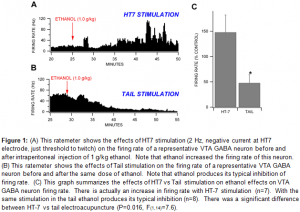Christine H. Walton and Dr. Scott C. Steffensen, Psychology/Neuroscience
Brief Explanation
Although my proposal for the ORCA grant involved the effects of nicotine on neurons in the VTA, preliminary data showed little to no promise and my mentor and I decided to go in a different direction.
Background
Recent studies have suggested that neurons in the ventral tegmental area (VTA) are influenced by electroacupuncture stimulation (Lee, 2008). Previous research has found that actupuncture at Shenmen (HT7) points suppressed a decrease of dopamine in the nucleus accumbens in rats in ethanol-withdrawal. It also inhibited behavioral withdrawal signs of ethanol. Further investigation suggests a role of the γ-aminobutyric acid (GABA) receptor system in acupuncture, as GABA neurons exert great influence on the activity of dopamine-releasing neurons. Researchers suspect that stimulation at acupuncture sites HT7 and PC6 in rats facilitates the amelioration of effects of acute ethanol in the VTA (Lee, et al 2008). The purpose of this experiment was to observe electrophysiological recordings of neurons in the VTA to observe changes in neuron firing rate during electroacupuncture stimulation. Once a baseline effect of acupuncture on “sober” neurons was established, we evaluated whether the behavioral manifestations of the acupuncture treatment of alcohol was a reflection of changes in neuronal activity.
Methods
We anesthetized rats with isoflurane. Extracellular potentials in anesthetized rats were recorded by a single 3.0 M NaCl filled micropipette (5-10 M; 1-2 µm inside diameter), amplified with an Axoprobe-1A microelectrode amplifier/headstage (Axon Instruments, Union City, CA). Microelectrodes were placed in the VTA stereotaxically (5.7-6.2 mm posterior from Bregma, 0-1 mm from midline, and 6.5-7.5 mm ventral to brain surface).
We then inserted acupuncture needles at acupuncture sites HT7 and PC6 in the right forepaw. Non-acupuncture control sites are located at the base of the tail. Stimulation via the acupuncture needles was generated and controlled by the MASTER-8 Pulse Generator (AMPI, Israel). A negative current of 1.4 mA was passed through the needles at 2 Hz, and visual twitching of the muscle is observed to verify correct needle placement.
Neuron firing rate was measured via the micropipette, amplified, and graphed on a ratemeter program prior to, during, and after electroacupuncture stimulation. Once a predictable effect of electroacupuncture on VTA neuron firing rate was established, 1 g/kg ethanol was administrated via injection into the intra-peritoneal (IP) space. Electroacupuncture stimulation continued during ethanol injections and throughout the remainder of the experiment. Firing rate was recorded up to 30 minutes after the IP injection.
Results
Discussion
It appears that HT7 electroacupuncture is blocking the effects of acute ethanol on VTA GABA neurons. Sensory stimulation at non-acupuncture points in the tail did not appear to increase firing rate or overcome the inhibition of firing rate induced by alcohol administration. Firing of VTA GABA neurons typically acts to inhibit dopamine release by dopaminergic neurons in the VTA; release of dopamine is associated with the reward pathway and subsequently addiction. The observed increase in firing rate during acupuncture stimulation may suggest that it blunts or blocks the addictive actions of alcohol in the brain. The next step is to record dopamine release in the nucleus accumbens in anesthetized rats with medial forebrain bundle stimulation.

